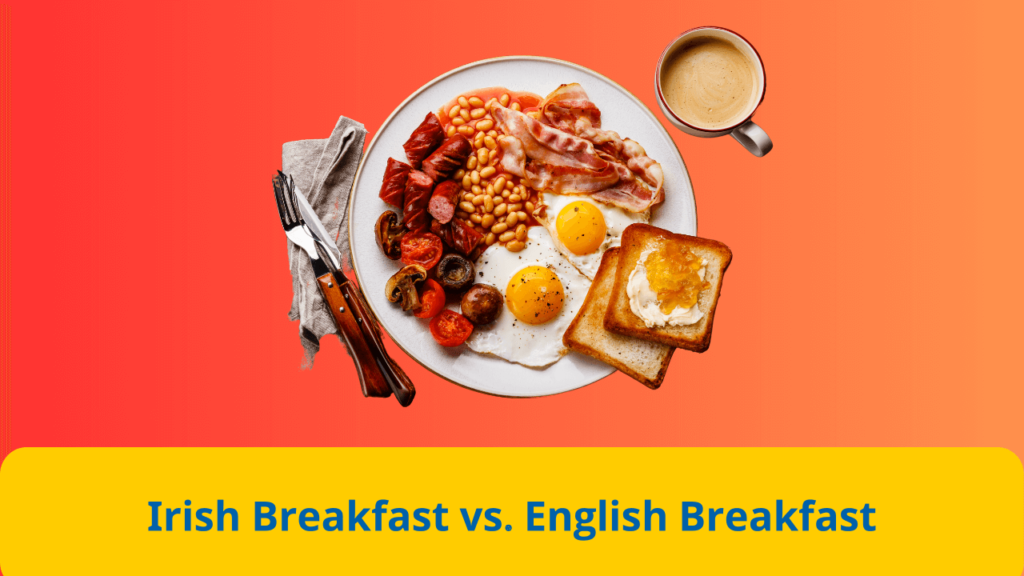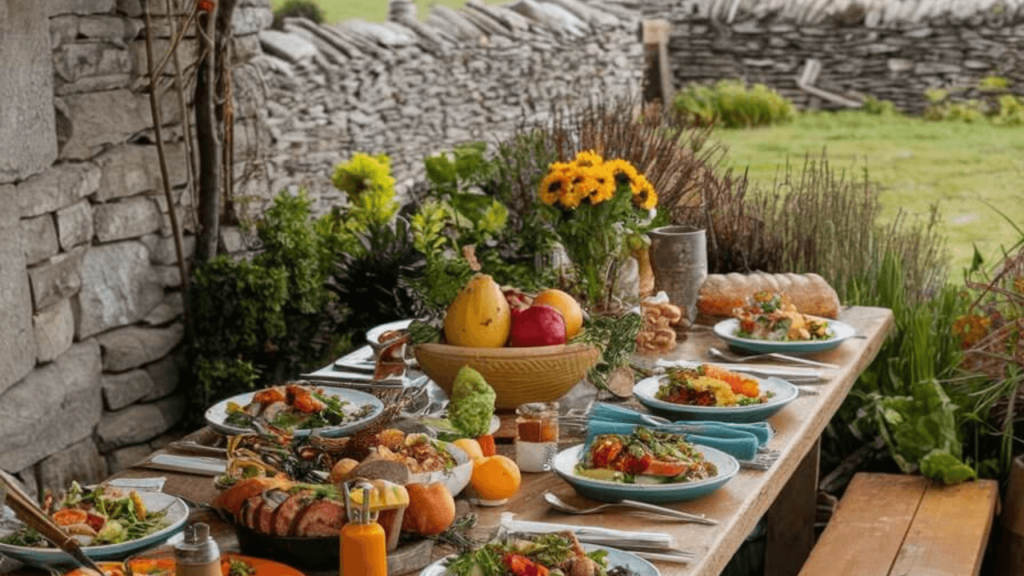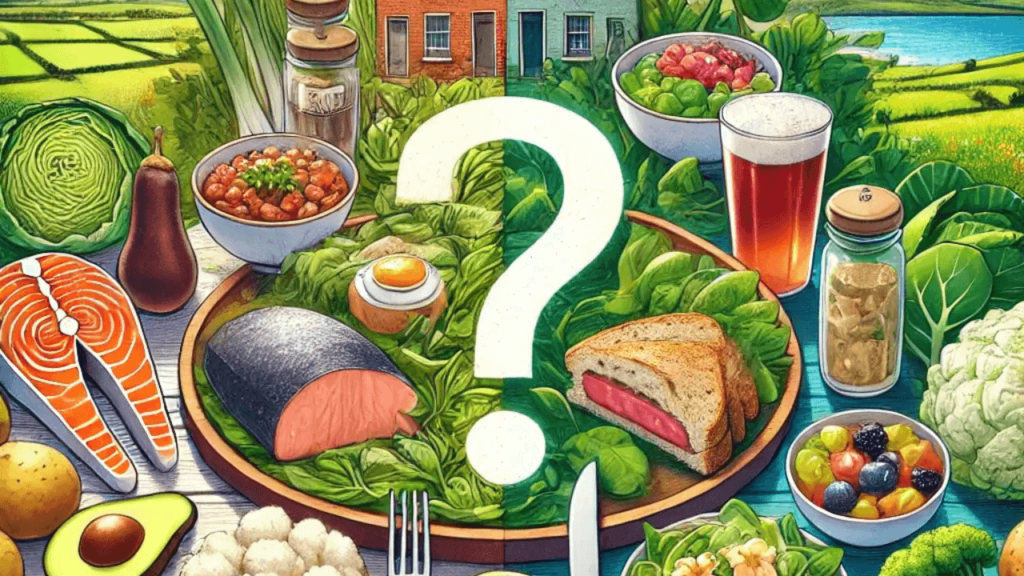Breakfast is often referred to as the most important meal of the day, and in Ireland and England, this is taken seriously. Both Irish and English breakfasts are hearty, traditional meals designed to fuel the body for the day ahead. While they share some similarities, they also have distinct differences that make each unique. In this article, we’ll explore the components, origins, and variations of Irish and English breakfasts, helping you understand what sets them apart.
What is a Traditional Irish Breakfast?
An Irish breakfast is a filling meal that originated from the Irish countryside. Farmers needed a lot of energy for their physically demanding work, and this breakfast was designed to provide that.
Common Components of an Irish Breakfast:
- Rashers (Irish bacon): Thicker and more flavorful than standard bacon.
- Sausages: Usually pork sausages with a rich, meaty taste.
- Black Pudding: A blood sausage made with pork blood, fat, and oatmeal.
- White Pudding: Similar to black pudding but without the blood.
- Fried Eggs: Typically cooked sunny-side up or over-easy.
- Potatoes: Often served as potato bread or boxty (a type of potato pancake).
- Grilled Tomatoes: Halved and lightly grilled to add a touch of sweetness.
- Baked Beans: Not always included but becoming more common.
- Brown Bread: Dense, hearty bread served with butter.
What is a Traditional English Breakfast?
The English breakfast, also known as a “Full English,” has been a staple in British cuisine for centuries. It’s commonly served in households, hotels, and cafes across England.
Common Components of an English Breakfast:
- Back Bacon: Leaner than streaky bacon, with a balance of meat and fat.
- Sausages: Often pork sausages, slightly spiced.
- Fried Eggs: A must-have in a full English breakfast.
- Black Pudding: Similar to Irish black pudding, but recipes may vary slightly.
- Fried Bread: Bread fried in butter or oil, adding a crispy texture.
- Baked Beans: A sweet and savory addition.
- Grilled Tomatoes: A juicy, flavorful component.
- Mushrooms: Usually fried or grilled.
- Toast: Lightly buttered and served as a side.
Irish vs. English Breakfast: Key Differences
Although both meals are hearty and satisfying, here’s a breakdown of how they differ:
| Feature | Irish Breakfast | English Breakfast |
|---|---|---|
| Meat | Includes white pudding and boxty | Often includes mushrooms and fried bread |
| Bread | Dense Irish brown bread or soda bread | Toast or fried bread |
| Potatoes | Frequently included as a key component | Rarely included |
| Beans | Less common but sometimes included | A staple component |
| Origins | Irish countryside tradition | English working-class tradition |
Origins and Cultural Significance
Irish Breakfast:
- Rooted in rural Ireland, this meal was designed to sustain farmers through long hours of work.
- It reflects Ireland’s agricultural heritage, with local ingredients like potatoes, pork, and oats.
English Breakfast:
- Originated during the Victorian era, symbolizing the growing British middle class.
- It became a hallmark of English culture, emphasizing variety and indulgence.
Cooking Methods: A Step-by-Step Guide
How to Make an Irish Breakfast:
- Fry or grill the rashers until crispy.
- Cook the sausages until golden brown.
- Slice and fry the black and white puddings.
- Prepare the potato bread or boxty in a frying pan.
- Grill the tomatoes and toast the brown bread.
- Fry the eggs and assemble everything on a plate.
How to Make an English Breakfast:
- Fry the back bacon until crispy.
- Cook the sausages until browned.
- Fry the eggs to your preference.
- Prepare the mushrooms and grilled tomatoes.
- Fry a slice of bread or prepare toast.
- Warm the baked beans in a saucepan and serve everything together.
Which Breakfast is Healthier?
| Nutrient | Irish Breakfast | English Breakfast |
|---|---|---|
| Calories | Higher due to potatoes and puddings | Moderate due to mushrooms and beans |
| Protein | High (sausages, eggs, bacon) | High (sausages, eggs, bacon) |
| Fiber | Moderate (brown bread) | Higher (baked beans, toast) |
| Fats | Higher due to fried components | Slightly lower but still significant |
Regional Variations
Irish Breakfast Variations:
- In Northern Ireland, an “Ulster Fry” includes soda bread and potato farls.
- Some versions incorporate smoked salmon for a coastal twist.
English Breakfast Variations:
- In Scotland, a “Full Scottish” adds haggis and tattie scones.
- In Wales, laverbread (seaweed) and cockles are unique additions.
Modern Adaptations
Healthier Versions:
- Grill the components instead of frying to reduce fat content.
- Use whole-grain bread and leaner cuts of meat.
- Add fresh fruit or a smoothie for a balanced meal.
Vegetarian Options:
- Replace meat with vegetarian sausages and plant-based puddings.
- Add more vegetables like spinach, avocado, or sweet potatoes.
Which is the Better Option?
Choosing between an Irish and an English breakfast depends on your preferences:
- Irish Breakfast: Perfect for potato lovers and those seeking a hearty, rustic meal with unique elements like white pudding and boxty.
- English Breakfast: Great for variety, with staples like mushrooms, fried bread, and baked beans adding balance to the plate.
If you prefer a more traditional, carb-rich meal, the Irish breakfast might be your favorite. For a breakfast with more components and flavors, the English breakfast could win your heart. Ultimately, both are delicious and worth trying!
FAQs about Irish Breakfast vs. English Breakfast
1. Are Irish and English breakfasts the same?
No, while they share some similarities, Irish breakfasts often include white pudding, potato-based items like boxty, and brown bread, whereas English breakfasts typically feature baked beans, fried bread, and mushrooms.
2. Which breakfast is healthier?
The English breakfast may be slightly healthier due to the inclusion of baked beans and mushrooms, which add fiber and nutrients. However, both are hearty meals with fried components, so moderation is key.
3. Can vegetarians enjoy these breakfasts?
Yes! Vegetarian versions replace meat with plant-based sausages, grilled vegetables, and additional sides like avocado or spinach.
4. What drinks are typically served with these breakfasts?
Both breakfasts are commonly accompanied by tea (Irish or English breakfast tea) or coffee. Fresh orange juice is also a popular option.
5. Where can I try authentic Irish and English breakfasts?
Authentic Irish breakfasts are widely available in Ireland at B&Bs, hotels, and local cafes. English breakfasts can be found across the UK, especially in traditional pubs and diners. Many Irish pubs abroad also serve both styles.
Conclusion
Both Irish and English breakfasts are rich, flavorful, and steeped in tradition. While they share some similarities, their unique components and cultural roots make them special in their own way.
Whether you prefer the potato-rich Irish breakfast or the variety of an English breakfast, both are delightful meals that offer a taste of their respective cultures.
So, which one would you try first?

Hi, I’m Tanvir, the founder and author of Explore Ireland Now. With a deep love for Ireland and its rich culture, history, and landscapes, I created this site to share everything that makes this beautiful country worth exploring. Whether you’re a local looking for hidden gems or a traveler planning your next adventure, I provide insightful guides, tips, and recommendations to help you experience Ireland to the fullest.
From stunning landscapes to vibrant cities and quaint villages, Ireland is full of wonders waiting to be discovered. Through my personal experiences and research, I aim to bring you the most up-to-date information and inspiration for your journey.
Thank you for visiting Explore Ireland Now—I hope my content helps you uncover all that this incredible country has to offer! If you have any questions or need travel advice, feel free to reach out.



